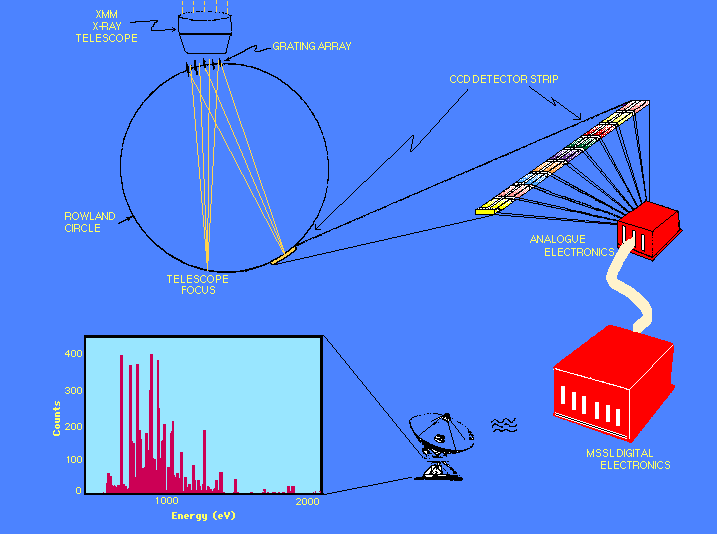

XMM-Newton is the second cornerstone mission in the European Space Agency (ESA) Horizon 2000 programme and was launched on an Ariane 5 rocket from Kourou, French Guiana, on 10th December 1999.
The Reflection Grating Spectrometer (RGS) provides the XMM-Newton observatory with unparalleled sensitivity for high resolution spectroscopy of cosmic sources in the soft X-ray band (0.35 - 2.5 keV, or 3.5 - 0.5 nm).
Instrument design
The RGS consists of two identical, coaligned instruments fitted to two of the three X-ray telescopes onboard XMM-Newton (the above cartoon shows only one RGS instrument). Each instrument incorporates an array of reflection gratings placed in the converging beam at the exit of the X-ray mirrors: the grating stack reflects roughly half of the X-ray light to an array of nine detectors offset from the telescope focus; the remaining light passes undeflected through the grating stack and it can be utilised by the European Photon Imaging Camera (EPIC) instruments located at the telescope primary focus. The grating stack, the telescope focus and the detector array lie on a large Rowland circle (of 3.3 m radius) to eliminate image aberrations.
The nine detectors are Charge Coupled Devices (CCDs) arranged in a strip: the spectrum of an on-axis point source will appear as a line image along the detector array. The position of an X-ray event along the CCD image of the spectrum provides a very accurate measure of the energy of the input photon. The inherent energy resolution of the CCDs is used to separate the first and second spectral orders which are overlapping. The cooling of the CCDs is achieved by means of a passive radiator.
The Department of Space and Climate Physics at the Mullard Space Science Laboratory (MSSL), part of University College London, is a Co-Investigator institute for the RGS; the instrument is built by an international collaboration led by the Space Research Organisation of the Netherlands (SRON) and including institutes from the U.S.A. and Switzerland.
Scientific impact of the XMM-Newton RGS
Point of contact:
Dr G. Branduardi-Raymont
Mullard Space Science Laboratory
Holmbury St Mary
Dorking, Surrey
RH5 6NT
Tel. (+44) 01483 204133 (direct)
Fax (+44) 01483 278312
Back to ...
XMM-Newton at the
European Space Agency